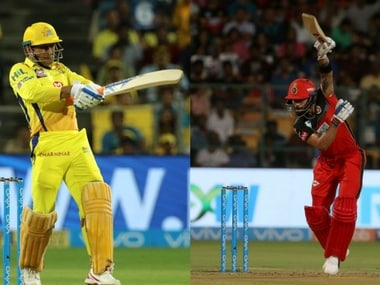India dithers over playing day-night Test cricket: Is fear of ceding ground to Australia the reason?
When it comes to pink ball cricket, why does India see red?
Austin Coutinho, May 05, 2018
T20 LEAGUE POINTS TABLE
| Pos. | Team | P | W | L | D | Pts. |
|---|---|---|---|---|---|---|
| 1 | Hyderabad |
8 | 6 | 2 | 0 | 12 |
| 2 | Chennai |
9 | 6 | 3 | 0 | 12 |
| 3 | Kolkata |
9 | 5 | 4 | 0 | 10 |
| 4 | Punjab |
8 | 5 | 3 | 0 | 10 |
| 5 | Mumbai |
9 | 3 | 6 | 0 | 6 |
| 6 | Bangalore |
8 | 3 | 5 | 0 | 6 |
| 7 | Delhi |
9 | 3 | 6 | 0 | 6 |
| 8 | Rajasthan |
8 | 3 | 5 | 0 | 6 |
DEPENDABLE PLAYER
for today’s match
voting results
- Indian Premier League, 2018 PUN Vs MUM Mumbai Indians beat Kings XI Punjab by 6 wickets
- Indian Premier League, 2018 KOL Vs CHE Kolkata Knight Riders beat Chennai Super Kings by 6 wickets
- Bangladesh Women in South Africa, 5 ODI Series, 2018 SAW Vs BANW South Africa Women beat Bangladesh Women by 106 runs
- Bangladesh Women in South Africa, 5 ODI Series, 2018 SAW vs BANW - May 6th, 2018, 01:15 PM IST
- Bangladesh Women in South Africa, 5 ODI Series, 2018 SAW vs BANW - May 9th, 2018, 01:15 PM IST
- Bangladesh Women in South Africa, 5 ODI Series, 2018 SAW vs BANW - May 11th, 2018, 01:15 PM IST
- Bangladesh Women in South Africa, 5 ODI Series, 2018 SAW vs BANW - May 14th, 2018, 01:15 PM IST
- Bangladesh Women in South Africa, 3 T20I Series, 2018 SAW vs BANW - May 17th, 2018, 04:30 PM IST
- Bangladesh Women in South Africa, 3 T20I Series, 2018 SAW vs BANW - May 19th, 2018, 05:45 PM IST
- Bangladesh Women in South Africa, 3 T20I Series, 2018 SAW vs BANW - May 20th, 2018, 06:00 PM IST
- New Zealand Women in Ireland, Only T20I, 2018 IREW vs NZW - Jun 6th, 2018, 08:30 AM IST
- New Zealand Women in Ireland, 3 ODI Series, 2018 IREW vs NZW - Jun 8th, 2018, 04:00 PM IST
- South Africa Women in England, 3 ODI series, 2018 ENGW vs SAW - Jun 9th, 2018, 03:30 PM IST
| Rank | Team | Points | Rating |
|---|---|---|---|
| 1 | India | 3499 | 125 |
| 2 | South Africa | 3589 | 112 |
| 3 | Australia | 3499 | 106 |
| 4 | New Zealand | 2354 | 102 |
| 5 | England | 3511 | 98 |
| 6 | Sri Lanka | 2914 | 94 |
| Rank | Team | Points | Rating |
|---|---|---|---|
| 1 | England | 5257 | 125 |
| 2 | India | 5492 | 122 |
| 3 | South Africa | 3842 | 113 |
| 4 | New Zealand | 4602 | 112 |
| 5 | Australia | 3327 | 104 |
| 6 | Pakistan | 3279 | 102 |
| Rank | Team | Points | Rating |
|---|---|---|---|
| 1 | Pakistan | 2990 | 130 |
| 2 | Australia | 1894 | 126 |
| 3 | India | 3932 | 123 |
| 4 | New Zealand | 2542 | 116 |
| 5 | England | 1951 | 115 |
| 6 | South Africa | 2058 | 114 |





“Uneasy lies the head that wears the crown.”
When it comes to pink ball cricket, why does India see red? Is the numero uno Test playing nation in the world scared of taking on Australia in a day-night Test match this December? Will Virat Kohli and his team, by agreeing to play a pink ball Test at Adelaide, concede an undue advantage to the host team?
On the face of it, coach Ravi Shastri’s asking for at least 18 months to prepare for day-night cricket seems to be a stalling tactic. The Duleep Trophy championship in India has been played with the pink ball for the last couple of years. Has that experiment failed? Hasn’t the experience of playing with the pink ball in that tournament, under lights, helped Indian players?
For the record, beginning December 2015, the Australians have played four Test matches under floodlights and have won all of them. They have beaten New Zealand, South Africa and England in pink ball Tests at Adelaide and have won a closely fought encounter against Pakistan at The Gabba.
Test playing nations like England, Australia, South Africa, the West Indies, New Zealand, Pakistan, Sri Lanka and Zimbabwe have all played day-night Test matches at least once. India — along with newbies, Afghanistan and Ireland — are yet to play a pink ball Test. And if the interim chief of the Board of Control for Cricket in India (BCCI), Vinod Rai is to be believed, India isn’t in the mood of playing one very soon. At least not for the next three or four years!
Cricket Australia’s (CA) CEO, James Sutherland believes that India is scared of losing the Adelaide Test, if it is played with the pink ball, looking at Australia’s awesome record in the new format. “The Indians are desperate to win in Australia. They are not bothered about the future of Test cricket,” Sutherland is said to have told reporters recently.
Rai, on the other hand, has said that CA can’t force BCCI to accept day-night Test matches by pointing a gun to its head. “Tour fixtures are mutually agreed upon and we are not going to agree to play the Adelaide Test in the day-night format,” said Rai. The message is clear — heads, the all powerful, cash-rich BCCI wins; tails, CA loses.
When it comes to pink ball cricket, why does India see red? Is the numero uno Test playing nation in the world scared of taking on Australia in a day-night Test match this December? Illustration courtesy Austin Coutinho
In fact, India had requested New Zealand — who had played the first ever pink ball Test against Australia, at Adelaide, in December 2016 — to play a day-night Test in India on their last tour. The Kiwis had politely refused. In March 2018, however, the New Zealanders played a day-night Test against England, at Auckland, and won by an innings and 49 runs.
If India was prepared to play New Zealand in a day-night Test match in India, a couple of years ago, why is it that they are not ‘ready’ now?
Day-night Test matches have their advantages. Evening matches will attract far bigger crowds in the long run. In hotter climes like Australia, the West Indies and the sub-continent, cooler evenings will mean more comfort for players as well as for spectators. Again, like T20 cricket, the new timings will mean that followers of the game don’t have to miss out on office or close down their businesses to be at the stadium, or to watch matches on TV.
On the flip side, there are various issues with the day-night format in Tests that haven’t been dealt with satisfactorily, over the last couple of years that it has been played. One major issue is the pink ball. Since the traditional red cherry isn’t visible against the night skies and floodlit backgrounds in stadiums, experiments with orange-red and pink balls were conducted. The pink ball was in fact selected as the lesser of the two evils!
The pink cricket ball is said to move a lot at times, especially in the twilight hour, and at other times refuses to swing or seam at all. Matt Renshaw, who has played the format a few times says, “Some deliveries move prodigiously; some don’t. You are kept guessing all the while.” The other problem is that batsmen and fielders, most of the times, during the changeover from daylight to floodlights, find it difficult to gauge the speed and distance of the pink ball.
Scientific studies have even suggested that the pink ball could be dangerous to players who are partially colour blind. Most partially colour blind persons do not even know they have this problem. Hence, when they play day-night matches with the pink ball, which they can’t pick against the green grass or other colours of the stadium, they could injure themselves grievously.
On sub-continental grounds, the dew factor plays a major role in day-night matches. The pink ball which softens up after a few overs will therefore absorb a lot of water from the outfield, becoming slippery and fluffed. The ball may therefore be required to be changed frequently during a Test match innings.
Day-night Tests have a 2 pm start. There are breaks usually at 4 pm for tea and then at 6.20 pm for supper. In England, the lights come on at 6.20 pm, during the second break, since days there are longer. In India, especially at Kolkata, lights will need to come on at around 4 pm. Therefore, while in England, two-thirds of the match will be played in daylight, in a place like Kolkata, only one-third of the match will be in day light. Match timings, to be standardised, may therefore have to be altered according to twilight timings at different Test match centres.
Traditionalists, who initially scoffed at the idea of day-night Tests, have suggested the use of white balls for Test matches. “If red can become pink and timings can be changed, what’s wrong in players donning coloured clothing for Test matches?” they ask. In fact, the ‘Super Tests’ of the Packer Series in the 1970s which were played under floodlights, had players wearing coloured ‘pajamas’. The white ball — tried and tested in limited over cricket — could be a better alternative for day-night Tests.
For India, it has been a hard climb to the top of the heap in Test match cricket. But as they say, becoming the best is easy; staying at the top is a tough ask. For BCCI, and for the Shastri-Kohli team, the fear of failure could be a debilitating factor here on. Naturally, therefore, there is the reluctance to take on anything that is unfamiliar and threatening.
BCCI, with its financial clout and its position in the game, has a leadership role to play in cricket’s growth. Rather than resisting change, therefore, India should be playing a pivotal role in making the game better for all its stakeholders. Day-night Test cricket could be the future of the game and BCCI’s involvement in making it happen will surely help; even if it is played with a white ball and with coloured pajamas!
The alternative for an edgy and anxious Indian team is to play a beleaguered West Indies, or Afghanistan and Ireland, under lights, to get used to the new format. That way, perhaps, India can also stay numero uno in Tests for a long time to come!
The author is a caricaturist and sportswriter. A former fast bowler and coach, he is now a sought-after mental toughness trainer.
Updated Date:May 05, 2018
Also See
BCCI need not push Indian team into playing Day-Night cricket; refusing to play Adelaide Test with pink ball is a right call
Indian cricket team and management refuse to play day-night Test during Australia tour, says member of CoA
Indian teams for one-off Afghanistan Test, limited-overs leg of UK tour to be announced on 8 May